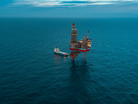INEOS CO₂ Storage Facility Paves Way for Carbon Capture

It may not be possible to reach net zero in time to prevent catastrophic climate change without CCS.
The International Energy Agency (IEA) says that to reach the Paris Agreement’s goals, 14% of emission reductions must come from CCS by 2060.
This increases to 32% to prevent global warming of two degrees.
INEOS leads a consortium of 23 partners that has been collecting and storing waste CO₂ since 2014.
Project Greensand is its first full value chain exercise to capture, liquify and ship CO₂ before storing it.
“All the parts of the process had been developed and worked well in isolation,” says David Bucknall, CEO of INEOS Energy.
“Connecting the parts and building the infrastructure was the challenge.”
The development of Project Greensand
The Project Greensand consortium includes big names like INEOS Energy, Harbour Energy, Ramboll and Semco Maritime.
The consortium represents the entire process of CO₂ storage, from start-ups that can capture it to shipping companies that can transport it.
In 2021, the consortium ran a pilot project where CO₂ was captured from the INEOS Oxide factory in Belgium.
The pilot phase was supported by the Energy Technology Development and Demonstration Programme (EUDP) in Denmark.
This CO₂ was liquified and shipped to the Nini West platform in the North Sea where it was injected into a sandstone reservoir 1,800 metres below the seabed for permanent storage.
H.R.H. Crown Prince Frederik officially initiated the storage of CO₂ in Denmark's subsurface on March 8, 2023, at the First Carbon Storage event.
Sir Jim Ratcliffe, Founder and Chairman of INEOS, says: “This is a breakthrough for Carbon Capture and Storage.
“It is the first time that carbon dioxide has been successfully captured, transported cross-border and safely stored offshore anywhere in the world.”
In 2022 the storage area was extended to the Nini Main field with newly established CO₂ injection wells and CO₂ was transported using larger ships.
Project Greenfield’s technology
Offshore CO2 storage facilities must be able to monitor and verify reservoir integrity after storing CO₂ to avoid potential risks.
The UK’s National Oceanography Centre (NOC) pioneered an approach to offshore CO₂ storage monitoring using novel chemical sensors.
The Strategies for Environmental Monitoring of Marine Carbon Capture and Storage (STEMM-CCS) project, funded by the European Union’s Horizon 2020 programme with principal industry partner Shell, allowed NOC to develop its ‘lab-on-chip’ sensors.
The sensors were able to detect and quantify a deliberate controlled release of CO₂ in the North Sea under the STEMM-CSS project, mimicking a release from a CO₂ injection process.
NOC is designing and developing a more robust CCS monitoring system with sensors suitable for long-term use for Project Greenfield.
The future of Project Greenfield
INEOS announced in September 2024 that “Denmark has a safe and well-functioning storage for CO₂ in the North Sea subsoil, where CO2 can be permanently stored to mitigate climate change.”
The pilot project’s final report has been submitted and the consortium’s work is ready.
Technical verification of the project has shown the stored CO₂ remains safely and permanently stored as expected as independently verified by DNV.
“We now have documentation that we have a well-functioning storage for CO₂ in the North Sea subsoil, where large amounts of CO₂ that would otherwise have been emitted into the atmosphere can be safely and permanently stored”, says Mads Gade, Country Manager at INEOS Denmark and Commercial Director at INEOS Energy.
“We are very proud that we are the first in the world to succeed in developing, testing and demonstrating a well-functioning value chain for safe and efficient capture, transport and storage of CO₂ across national borders with the aim of mitigating climate change.
“This is an important step on the way to meeting Denmark's and the EU's climate ambitions, and each of the 23 partners has done an outstanding job.
“I am impressed by how the task has been solved across many professional groups, which has made this phase of Project Greensand come together.”
From 2025 to 2030, the storage areas will be expanded to include the Siri Fairway to reach storage capacity of 8 million tonnes of CO₂ per year.
INEOS is now working hard to start CO₂ storage in the North Sea by the end of 2025 or beginning or 2026.
******
Receive the next edition of ClimateTech Magazine by signing up for its newsletter.
As part of this portfolio, make sure you check out Sustainability Magazine and also sign up to our global conference series - Sustainability LIVE.
Also check out our Sister Brand, Energy Digital.
*****

